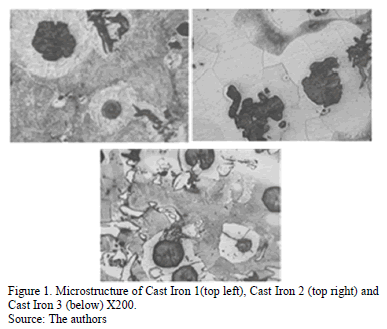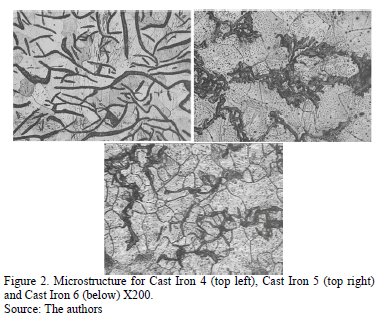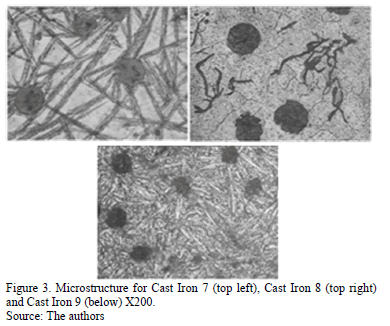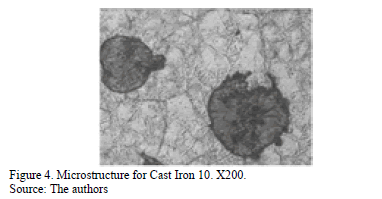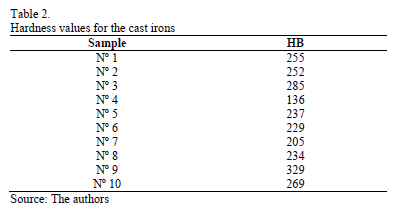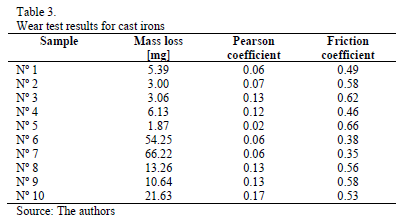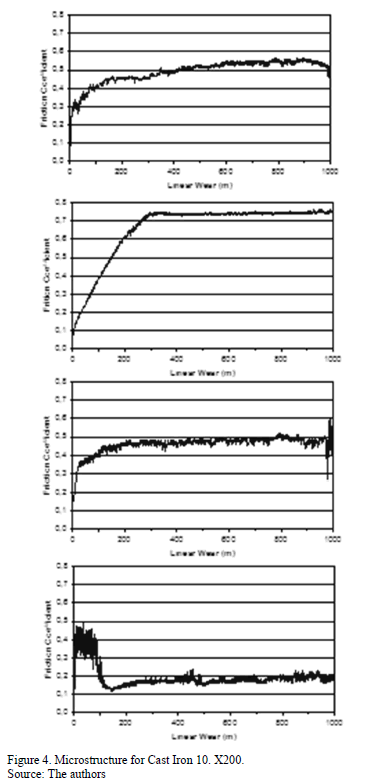Services on Demand
Journal
Article
Indicators
-
 Cited by SciELO
Cited by SciELO -
 Access statistics
Access statistics
Related links
-
 Cited by Google
Cited by Google -
 Similars in
SciELO
Similars in
SciELO -
 Similars in Google
Similars in Google
Share
DYNA
Print version ISSN 0012-7353
Dyna rev.fac.nac.minas vol.81 no.188 Medellín Nov./Dec. 2014
https://doi.org/10.15446/dyna.v81n188.41809
http://dx.doi.org/10.15446/dyna.v81n188.41809
Influence of silicon on wear behaviour of "Silal" cast irons
Influencia del silicio en el comportamiento al desgaste de las fundiciones tipo "Silal"
Ana I. García-Diez a, Carolina Camba-Fabal b, Ángel Varela-Lafuente c, Víctor Blázquez-Martínez d, José Luís Mier-Buenhombre e & Benito Del Río-López f
a Escuela Politécnica Superior, Universidade da Coruña, A Coruña, España. agd@cdf.udc.es
b Escuela Politécnica Superior, Universidade da Coruña, A Coruña, España. ccamba@.udc.es
c Escuela Politécnica Superior, Universidade da Coruña, A Coruña, España. anvalaco@cdf.udc.es
d Escuela Técnica Superior de Ingenieros Industriales, Universidad Politécnica de Madrid, Madrid, España. vblazquez@etsii.upm.es
eEscuela Politécnica Superior, Universidade da Coruña, A Coruña, España. jlmier@.udc.es
f Escuela Técnica Superior de Ingenieros Industriales, Universidad Politécnica de Madrid, Madrid, España. bdelrio@etsii.upm.es
Received: January 29th, 2014. Received in revised form: July 29th, 2014. Accepted: August 5th, 2014.
Abstract
The tribological and mechanical properties of various cast irons with different contents of carbon and silicon are studied. The Brinell hardness or every cast iron was measured and their wear resistance was calculated according to ASTM G99 standard, "Standard Test Method for Wear Testing with a Pin-on-Disk Apparatus. These results were related to microstructure, composition and casting processes of the cast irons. The best wear behaviour was experienced by the cast irons with spheroidal graphite and a ferrite matrix in their microstructure. At the same time, the cast irons with the lowest wear resistance are those that have flaky graphite and a purely ferrite matrix in their microstructure. In addition, various casting processes have been tested in order to determine their influence on the appearance of spheroidal graphite.
Keywords: High-alloy graphitic irons; silicon; wear.
Resumen
En este trabajo se ha evaluado la influencia del contenido de silicio en la resistencia frente al desgaste y en las propiedades mecánicas de diferentes fundiciones con alto contenido en silicio del tipo Silal. Para ello se ha variado el contenido en carbono y en silicio de las muestras, evaluando posteriormente la modificación en la dureza, determinada mediante la escala Brinell, y en el comportamiento tribológico, estudiado mediante ensayos de desgaste normalizados Pin-on-Disk. Todo ello se ha complementado con un estudio metalográfico para determinar la influencia de la microestructura en las propiedades analizadas. Se ha determinado que el mejor comportamiento al desgaste lo presentan aquellas aleaciones cuya composición y proceso de colada garantizan el grafito esferoidal frente a las que lo presentan con estructura laminar. Adicionalmente, se ha experimentado con diferentes procesos de colada para la fabricación de las fundiciones para determinar su influencia en la aparición del grafito esferoidal.
Palabras clave: Fundiciones grises de alta aleación; silicio; desgaste.
1. Introduction
Among cast irons, there are ferritic cast irons with medium and high silicon content, known as Duriron and Silal, respectively. As well as being resistant to heat, the latter does not experience swelling when it is heated repeatedly or subjected to temperatures as high as 850ºC. A point to bear in mind is that it swells during casting because the graphite flakes are porous. These pores let oxidant gases pass so that they themselves are oxidized internally. Consequently, if it is heated beyond eutectic transformation temperature, the percentage of free graphite increases. This in turn may lead to a significant increase in its volume when ordinary grey cast irons are used.
Silal-type cast irons present a ferrite microstructure with graphite that is stable up to eutectic transformation temperature. Consequently, its capacity to resist oxidation at temperatures of 850ºC is very high and the problem of swelling is avoided. If these cast irons present spheroidal graphite, their behaviour can be improved even more [1].
On the whole, its composition has a silicon content between 5.5 and 7%, while the carbon content usually does not exceed 2.3%. The silicon dissolved in the ferrite weakens it so that its toughness and mechanical resistance are low. It has little resistance to thermal shock, although it performs better than grey cast irons.
Its mechanical properties and resistance to oxidation can be improved by adding magnesium to spheroidize the graphite. This step raises its tensile resistance by 20% while greatly improving its toughness. A further addition of molybdenum boosts its creep resistance. These cast irons tend to be used for oven racks or ashtrays, along with steam turbine components for continuous or intermittent work at temperatures ranging from 650 to 825ºC.
By partially substituting silicon for aluminum in percentages of between 4 and 6%, it is possible to make it more resistant to oxidization at high temperatures and increase its mechanical strength. However, alloys with aluminum are difficult to produce because that metal has a strong oxygen affinity [2-8].
The silicon content for the cast iron Duriron is higher than that of Silal: between 12 and 16%. This high content means that it has a ferrite microstructure due to the alphagenic characteristics of the silicon. It also means its carbon content is lower than that of Silal. It is extremely resistant to dry corrosion from acid oxidants but it is much more fragile than Silal. Very hard and difficult to manipulate mechanically, Duriron is also inferior to Silal in terms of its tensile strength and thermal shock resistance.
Resistance to corrosion is improved with the addition of molybdenum, but this is not the case with its mechanical properties. Duriron is used to make components that have to withstand electrochemical corrosion [9-15].
The performance of this type of casts iron on corrosion and high temperature conditions is well known, but there is little information about their tribological behaviour. Therefore, the purpose of this work is to evaluate their response to wear taking into account the composition and microstructure, in particular the presence of spheroidal graphite. Furthermore, different casting processes of these alloys have been tested to determine the best way to get this kind of graphite.
2. Experimental methods
This study was conducted on ten distinct castings prepared in the Pilot Foundry Plant at the Escuela Técnica Superior de Ingenieros Industriales of the Universidad Politécnica in Madrid. In each of these, the carbon and silicon contents were varied. The carbon content was varied between 1.5 and 2.7%, where as the silicon content was between 3.3 and 9.3%. The influence of silicon content on wear was evaluated in a wider range than usual composition for these alloys while the content of carbon was maintained within the usual range. The casting process was also changed from one alloy to another. Nickel magnesium was added in all the cases except in Casting 4 in which magnesium chloride was added. The amount of nickel magnesium in Casting 1 was five times less than in all other cases. The amount of Ni-Mg added was 2.7 % of the total weight of the castings in all cases except in the case of Casting 1, which was 0.5 %. On the other hand, the amount of MgCl2 added in the Casting 4 was 3.7 %. For all ten, the carbon and silicon contents were determined. The former was analyzed with a Leco CS-300 device, while the procedure from UNE 7-028-75 "Determining silicon gravimetric analysis in silicon and cast irons" [16] was followed to test the silicon content. Moreover, the hardness was tested for all ten, applying the Brinell scale and using a Hoytom tester with 2.5 mm diameter ballpoint indenter and an applied load of 187.5 kg [17].
Pin-on-disk tests were carried out to measure the wear resistance for each according to the mass loss caused by the casting process. These were informed by the procedure in ASTM G99 "Standard test method for wear testing with a pin-on-disk apparatus" [18]. Before doing these tests, it was necessary to prepare the surface of each sample so that the roughness was more uniform among all ten cast irons. By decreasing the roughness to minimum levels, the surface finish would not influence the results of the wear tests. With this surface preparation, the average roughness Ra in all ten samples was below 1.5mm. The samples were collected from the central part of the casting specimens, disposing the ends as they are the zones most susceptible to heterogeneities. A profilometry study of the samples surface was performed by making multiple passes in different directions. This permitted to discard the presence of porosity and surface defects that alter the results.
The following parameters were used. The tungsten carbide pin had a 4 mm diameter and a hardness of 75HRC. The samples were subjected to a load of 10N and each test included 1000 m of linear wear at a speed of 0.25m/s. The track radius on the surface was 8 mm. All tests were done at ambient temperature. The friction coefficient was also determined throughout the testing.
A minimum of three valid tests were performed for each simple. The Pearson coefficient was used to assess the accuracy of the results. This coefficient determines the relationship between the deviation of data and their mean. Values of this coefficient higher than 0.20 were discarded. Once the preparatory steps had been taken, the metalographic study of each cast iron was performed with an etching agent made up of 70% alcohol, 20% de nitric acid and 10% hydrofluoric acid, and an immersion time of five seconds per sample. Micrographies were taken of all ten samples.
3. Results
Table 1 offers data on the carbon and silicon content for each sample.
In Table 1 it is possible to observe that the carbon content in the samples falls between 1.56 and 2.71%. The lowest figure corresponds with Cast Iron 5, while highest is for Sample 4. In terms of the silicon, the values have an interval between 3.35 and 9.11%. At the lowest end of the scale is Sample 6 and, at the other end, is Sample 9.
Fig. 1 shows the micrographies of Cast Iron 1, 2 and 3. For the Cast Iron 1, it is possible to notice that the microstructure consists in spheroidal graphite (despite five times less nickel magnesium was used in casting) on a ferrite-pearlite matrix.
Cast Iron 2 shows spheroidal graphite that is less perfect in shape than the one in Cast Iron 1. In this case, graphite is distributed in a large amount of particles with widely varying sizes. That can be explained by the less silicon content (around 1.8% lower) when carbon content is constant. This is another case of the matrix becoming ferrite-pearlite, with the latter in lesser quantities
The microstructure for Cast Iron 3, also has spheroidal graphite and a ferrite-pearlite matrix.
Fig. 2-top left corresponds to the microstructure of Cast Iron 4. In this case, the graphite is not spheroidal, but rather flaky. Its matrix is entirely ferrite and not ferrite-pearlite, as in the previous cases. It is the only of the ten analyzed cast irons that shows entirely laminar graphite. This means that the casting process with magnesium chloride addition does not achieve the objective sought: the graphite spheroidization. Fig. 2-top right shows the microstructure of Cast Iron 5, with interdendritic graphite along the grain boundary. It is the only cast iron that shows this graphite form. Its matrix is entirely ferrite like in Cast Iron 4. The microstructure of Cast Iron 6 is shown in Fig. 2-below. It consists of flaky graphite, although in a smaller amount than in Cast Iron 4. Once again, it has an entirely ferritic matrix.
Fig. 3-top left shows the microstructure of Cast Iron 7. A spheroidal graphite with needle patterns- the more widespread characteristic- can be observed. Its matrix is ferrite.
As for Cast Iron 8, Fig. 3-top right presents a microstructure formed by spheroidal graphite; it is flaky over a ferrite matrix. In this sample, the presence of graphite is lower than in the previous case. At the same time, Fig. 3-below is the microstructure of Cast Iron 9. Spheroidal graphite appears, with a martensite and austenite matrix.
The last one is Fig. 4, with the microstructure of Cast Iron 10, composed of spheroidal graphite and a ferrite matrix. This microstructure is similar to that of the Casting 1 and Casting 2 with the difference that the matrix is entirely ferritic, without the presence of pearlite.
The last one is Figure 4, with the microstructure of Cast Iron 10, composed of spheroidal graphite and a ferrite matrix. This microstructure is similar to that of the Casting 1 and Casting 2 with the difference that the matrix is entirely ferritic, without the presence of pearlite.
Table 2 shows the hardness measurements for the different cast irons using the Brinell scale. The value shown is the average value of ten valid tests.
The hardness values range between 136 and 329 HB; the lowest results correspond with Cast Iron 4 and the highest, with Cast Iron 9.
The wear tests results of all samples can be seen in Table 3. The table represents wear resistance as mass loss expressed in milligrams, the variation coefficients for mass loss and the average friction coefficients in each test.
In Table 3 the mass loss values fall between 1.87 and 66.22 mg. The lowest value corresponds to Cast Iron 5, which also has the highest friction coefficient. The second lowest value relates to the mass loss Cast Iron 7; its friction coefficient was significantly lower than in the case of Cast Iron 5.
Fig. 5 displays the friction coefficient patterns obtained during the pin-on-disk wear tests carried out on the ten cast irons.
In the first, the patterns correspond with Cast Irons 1, 2, 8 and 10. It can be observed the coefficient of friction increases gradually during the test and stabilizes toward the end. The second portrays the friction coefficient throughout the wear test of Cast Irons 3, 5 and 9. The friction coefficient progressively increases during the initial third of the test and remains constant for the other two thirds. This pattern encompasses the highest friction coefficient values for the ten cast irons analyzed.
The third has the friction coefficient pattern for Cast Irons 4 and 6. At the start of the testing, it grows rapidly, but remains steady thereafter. The friction coefficient values are the lowest for the ten samples. The behaviour pattern of the friction coefficient of Cast Iron 7 throughout the wear test can be seen in the last one, the fourth one. This coefficient rises sharply at the outset of the testing only to drop dramatically at its midpoint and then remain steady for the rest of the time. After all of the results were analyzed, the influence of the chemical composition on the microstructure and the tribological properties of the material can be evaluated. The measured friction coefficient is higher in Casting 2 than Casting 1, whereas the weight loss in the wear test is higher in Casting 1 and the hardness is similar in both alloys. This can be explained by the distribution of the graphite particles which came off more easily in Casting 1, leading to a friction coefficient decrease (The detached graphite acts as a lubricant), while wear weight loss increases. Casting 3 microstructure is similar to Casting 1, however it has considerably higher hardness and better wear behaviour. The Casting 4 hardness is clearly the lowest of all the alloys tested, and the weight loss during wear is one of the highest along with Casting 6 which also shows laminar graphite. Furthermore, the friction coefficient of both cast irons follows the same pattern (third curve of the Fig. 5). This is a consequence of the graphite detachment which decreases the friction coefficient due to its lubricant properties.
Casting 5 is the only one that shows interdendritic graphite which is more difficult to come off and negatively affects to the lubricant properties of the alloy. This explains the high value of the friction coefficient
Casting 7 is the second in silicon content, whereas its carbon content is similar to those of Casting 1, Casting 2 and Casting 3. However, Casting 7 shows graphite mostly in needle form and in spheroidal form in much less extent. The friction coefficient pattern during the wear test is unique and that indicates a large mass detachment at the beginning of the test which acts as a lubricant and gives the lowest friction coefficient of all, but this does not prevent the wear of the ferritic matrix
Casting 8 has one of the highest carbon content whereas its silicon content is medium. The microstructure is similar to those of Casting 1 and Casting 2 except that Casting 8 shows graphite flakes in small quantities and, therefore, its hardness is significantly lower than the other two. The same happens with its wear resistance.
Despite the low carbon content, Casting 9 has the highest hardness due to the presence of martensite in an austenitic matrix. However, the mass loss values are higher than expected. The only explanation would be that the martensite needles were detached acting as abrasive particles during testing.
The Casting 10 microstructure is similar to those of Casting 1 a Casting 2 with the difference that the first one shows a completely ferritic matrix and the other two have a ferritic-perlitic structure. This last matrix is softer and gives a higher weight loss during wear because resists less abrasion and favours the graphite detachment [19].
An increase in hardness leads to a reduction in the mass loss during the wear test. There are some exceptions, all of these related to the cast irons that have a purely ferrite matrix in their microstructure.
4. Conclusions
The influence of carbon and silicon content, microstructure and Brinell hardness on wear behaviour of ten Silal-type cast irons is studied. Ni-Mg was added in nine of these cast iron, while only one was made from magnesium chloride.
The casting process with magnesium chloride is not effective to obtain spheroidal graphite and this implies worse results in wear tests.
The best wear behaviour was obtained in the cast irons with spheroidal graphite and ferrite matrix in their microstructure, and with medium silicon and carbon contents. The exception is cast iron 5 (with the lowest carbon content of this group), which is the only one with interdendritic graphite and experiences a weight loss slightly lower than the others. At the same time, the cast irons with the lowest wear resistance are those that have flaky graphite and a purely ferrite matrix in their microstructure. One of them is made with MgCl2 and the other one has a lower silicon content.
It has been possible to prove that, in general, while the carbon content in these kinds of cast irons increases, so does the mass loss.
References
[1] Gonzaga-Cinco; R. and Fernández-Carrasquilla, J., Dependencia de las propiedades mecánicas y de la composición química en la fundición de grafito esferoidal, Rev. Metal. Madrid, 42 (2) pp. 91-102, 2006. [ Links ]
[2] Pearce, J., Inoculation of cast irons: Practices and developments, Metal Casting Technologies, 53, pp. 16-22, 2007. [ Links ]
[3] Harvey, J.N. and Noble, G.A., Inoculation of cast irons-an overview. 55th Indian Foundry Congress, India, pp. 343-367, 2007. [ Links ]
[4] Loizaga, A., Sertucha, J. and Suárez, R., Influencia de los tratamientos realizados con diferentes ferroaleaciones de magnesio en la evolución de la calidad metalúrgica y los procesos de solidificación de las fundiciones esferoidales, Rev Metal Madrid, 44 (5) pp. 432-446, 2008. [ Links ]
[5] Skjegstad, N.T. and Skaland, T., Inoculation of grey and ductile iron. Bombay Foundry Congress. Bombay, India. pp. 1-23, 1996. [ Links ]
[6] Liu, S.L., Loper Jr., C.R. and Witter, T.H., The role of graphitic inoculants in ductile iron. AFS Transactions, 100, pp. 899-906, 1992. [ Links ]
[7] Subramanian, S.V., Kay, D.A.R. and Purdy, G.R., Compacted graphite morphology control. AFS Transactions, 90, pp. 589-603, 1982. [ Links ]
[8] Riposan, I., Chisamera, M., Stan, S. and Skaland, T., A new approach to graphite nucleation mechanism in gray iron. Proceedings of the AFS Cast Iron Inoculation Conference. Illinois, EEUU, pp. 31-41, 2005. [ Links ]
[9] Lu, Z.L., Zhou, Y.X., Rao, Q.Ch. and Jin, Z.H. An investigation of the abrasive wear behaviour of ductile cast iron. J Mater Process Tech, 116 (2-3) pp. 176-181, 2001. http://dx.doi.org/10.1016/S0924-0136(01)01013-5 [ Links ]
[10] Hirasata, K., Hayashi, K. and Matsunami, H., Friction and wear of spheroidal graphite cast iron under severe sliding conditions. 29th Leeds-Lyon Symposium on Tribology. Lyon, Francia, 41, pp. 643-652, 2003. [ Links ]
[11] Takeuchi, E., The mechanism of wear of spheroidal graphite cast iron in dry sliding, Wear, 19, pp. 267-276, 1972. http://dx.doi.org/10.1016/0043-1648(72)90119-6 [ Links ]
[12] Lu, Z.L., Zhou, Y.X., Rao, Q. Ch. and Jin, Z.H., An investigation of the abrasive behavior of ductile cast iron. J Mater Process Tech, 116 (2-3) pp. 176-181, 2001. http://dx.doi.org/10.1016/S0924-0136(01)01013-5 [ Links ]
[13] Shin, J.S., Lee, S.M., Moon, B.M., Lee, H.M., Lee, T.D. and Lee, Z.H., The effects of heat treatment condition and Si distribution on order-disorder transition in high Si steels, Met Mater Int, 10 (6) pp. 581-587, 2004. http://dx.doi.org/10.1007/BF03027422 [ Links ]
[14] Blázquez-Martínez, V., Metalografía de las aleaciones férreas, E.T.S.I.I., Madrid, 1991. [ Links ]
[15] Castillo, R., Bermont, V. and Martínez, V., Relations between microstructure and mechanical properties in ductile cast irons: A rewiew. Rev Metal Madrid, 35, pp. 329-334, 1999. http://dx.doi.org/10.3989/revmetalm.1999.v35.i5.641 [ Links ]
[16] Norma UNE 7-028, Determinación gravimétrica de silicio en aceros y fundiciones, 1975. [ Links ]
[17] Norma UNE-EN ISO 6506-1, Materiales metálicos. Ensayo de dureza Brinell. Parte 1: Método de ensayo, 2005. [ Links ]
[18] ASTM Standard G99, Standard test method for wear testing with a pin-on-disk apparatus, ASTM International, West Conshohocken, PA, 2008. [ Links ]
[19] Sierra, H., Vélez, J. and Herrera, C., Resistencia a la abrasión de fundición nodular aleada con cobre, austemperada a 300 ºC. DYNA, 137, pp. 51-59, 2002. [ Links ]
A.I. García-Diez, received her PhD in Industrial Engineering from Coruña University, Spain, in 2004 about abrasion-resistant ferrous alloys for use as carbon mills coatings. She is currently working as a lecturer at the Department of Industrial Engineering of Coruna University, Spain and is also member of the Materials Science and Engineering research group. Her research interests deal with the abrasive wear behavior of cast iron, manganese steel and copper. She has published about forty papers mainly on tribology of ferrous materials
C. Camba-Fabal, studied at the University of A Coruña, Spain, graduating in Industrial Engineering within the Materials Science specialty in 2007. She received her PhD degree from the same university in 2011. She is currently working as assistant lecturer in the field of Materials Science and Metallurgical Engineering at Higher Polytechnic School of Ferrol. Her research activity mainly concerns wear of ferrous alloys.
A.Varela-Lafuente, is MSc and PhD in Industrial Engineering from Polytechnic University of Madrid, Spain. He was Director of the Polytechnic High School at Coruna University, Spain from 2001 to 2005 Currently he is a lecturer at the same center He is member of the Materials Science and Engineering research group. He has many years of working experience in the field of metallurgy and his main scientific interests include the influence of the thermal and thermochemical treatments on the wear response of ferrous alloys on what he has published several papers during last years. He is member of the Spanish Mechanical Engineering Association
V. Blázquez-Martínez, is MSc and PhD in Industrial Engineering from Polytechnic University of Madrid. Currently he is a lecturer at the same center. He has many years of working experience in the field of metallurgy and his main scientific interests include the influence of the thermal and thermochemical treatments on the wear response of ferrous alloys on what he has published several papers during last years.
J.L. Mier-Buenhombre, is a lecturer and Head of the Materials Science and Engineering research group (CIM) at the Department of Industrial Engineering of the University of Coruna, Spain. He received his PhD in Metallurgy from Complutense University (UCM), Spain, in 1993. He achieved an award from UCM for his PhD thesis in 1995. He has published 40 publications related to extractive metallurgy and wear behavior of metallic materials, many of them in international publications. He is a member of the Spanish Mechanical Engineering Association.
B. Del Río-López, studied at the Polytechnic University of Madrid, Spain, graduating in Industrial Engineering within the Metallurgical specialty. He received his PhD degree from the University of A Coruña, Spain in 2013. He is currently working as assistant lecturer in the field of Materials Science and Metallurgical Engineering at Engineering from Polytechnic University of Madrid. His research activity mainly concerns wear of ferrous alloys.













